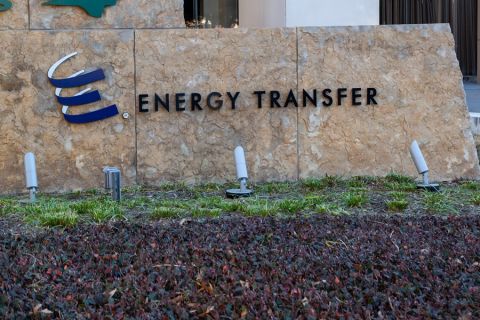
DUG Sand speakers, clockwise from top left, included: James Wicklund of Stephens Inc., Laura Fulton of Hi-Crush Partners LP, Hunter Wallace of Atlas Sand Co. LLC, and Erik Nystrom of Covia. (Source: Hart Energy)
FORT WORTH, Texas—Well before the discussion turned to granular issues of quality, speakers at the inaugural DUG Sand Conference addressed quantity. In short, there’s too much.
“This is one of the industry’s issues,” said James Wicklund, Dallas-based managing director of Stephens Inc.’s energy group, during his April 15 keynote. “As it turns out, we have an awful lot of sand.”
The surplus stems, most immediately, from the fourth-quarter price dives of frac sand and oil. But Laura Fulton, CFO for Hi-Crush Partners LP (NYSE: HCLP), compared recent troubles to the woes of second-quarter 2016 and saw a heartening contrast.
“What we experienced last fall was not the worst,” she said. “I was around for the worst and that was clearly April, May, June 2016 and I really don’t want to go back there as far as what was happening with prices.”
Much of that derived from the plunge in oil prices from the down cycle. The industry experienced that in Fall 2018, too, as a barrel of West Texas Intermediate (WTI) fell from the mid-$70s in early October to the low $40s by the end of the year.
But WTI has recovered to the mid-$60s and the rig count looks good, she said. So why is the industry taking so long to rev up to previous levels?
Because of lessons learned from the brutal second-quarter 2016, Fulton said.
It took almost a year—from the start of the down cycle in fourth-quarter 2014 to third-quarter 2015—for the frac sand industry to pull 40% of capacity offline because of economic, logistical or customer base issues.
“Starting in September [2018], when we saw that prices were declining dramatically for frac sand, particularly Northern white frac sand, the industry responded extremely quickly,” she said. Mines were idled and remain idled as Northern white sand producers slowly bring facilities back online.
“There’s going to be a constraint, even more so in 2019 moving into 2020 on Northern white sand production capacity,” she said. “We’re not going to be mining as much Northern white sand as we have in the past, building up inventories for the wintertime.”
And that’s a good thing. As oil production continues to ramp up, demand for Northern white will, as well.
“I think the industry is behaving rationally and working to make sure that we maintain prices at a certain level and we’re not economically disadvantaging ourselves and subsidizing our customers with the prices of sand,” Fulton said. “Prices have stabilized for Northern white sand. Lessons have been learned.”
Northern white sand continues to dominate in the unconventional plays, constituting a 55% market share, but cheaper in-basin sand has made inroads.
Demand for frac sand peaked in the Permian Basin around April 2018, said Erik Nystrom, vice president of strategic marketing at Covia. Since June 2018, the number of frac crews operating in the U.S. has declined 12%, taking with them a significant demand for sand.
The number of crews actually rose by 12% in the Rockies in the June 2018 to March 2019 time frame, but the other major shale plays—Permian Basin, Eagle Ford, Marcellus, Midcontinent, Bakken and Haynesville—experienced hits. The number of crews operating in the Midcontinent alone was reduced by 22% and in the Permian, 13%, according to Covia research.
As pipeline constraints likely ease in the Permian toward the end of 2019, the number of frac crews can be expected to increase along with a higher demand for sand. But will Northern white be able to maintain its advantage over in-basin?
“Clearly, I think everybody agrees Northern white has the highest quality,” Fulton said. “Are you willing to pay for it? That’s a different matter. That’s where we’ve really seen the in-basin sands, with the Permian in particular, take off.”
Since 2016, Northern white’s market share in the Permian Basin has shrunk from 61% to 37% while Permian in-basin’s share has risen from zero to 37%, according to the Atlas Sand Co. LLC presentation by COO Hunter Wallace. Almost all of the difference is made up by regional and non-Permian in-basin sand.
“Some of the Northern white is actually going into basins that do not have an in-basin option available,” said Wallace, explaining Northern white’s continuing overall market advantage.
Nystrom made the quality argument for Northern white:
· West Texas crush strength is more dependent on particle-size distribution than Northern White;
· West Texas has about two to three times more impurities than Northern white pure crystalline silica;
· West Texas material degrades fairly significantly due to the lesser strength of each individual grain of sand; and
· Northern white crushes more evenly and each grain is able to withstand more closure stress.
Wallace explained the dramatic tilt in the last two years toward in-basin product as one based on producer results, despite Northern white’s advantage.
“Over the same amount of time,” he said, “operator EURs have continued to get better.”
Recommended Reading
Report: Crescent Midstream Exploring $1.3B Sale
2024-04-23 - Sources say another company is considering $1.3B acquisition for Crescent Midstream’s facilities and pipelines focused on Louisiana and the Gulf of Mexico.
For Sale? Trans Mountain Pipeline Tentatively on the Market
2024-04-22 - Politics and tariffs may delay ownership transfer of the Trans Mountain Pipeline, which the Canadian government spent CA$34 billion to build.
Energy Transfer Announces Cash Distribution on Series I Units
2024-04-22 - Energy Transfer’s distribution will be payable May 15 to Series I unitholders of record by May 1.
Balticconnector Gas Pipeline Back in Operation After Damage
2024-04-22 - The Balticconnector subsea gas link between Estonia and Finland was severely damaged in October, hurting energy security and raising alarm bells in the wider region.
Wayangankar: Golden Era for US Natural Gas Storage – Version 2.0
2024-04-19 - While the current resurgence in gas storage is reminiscent of the 2000s —an era that saw ~400 Bcf of storage capacity additions — the market drivers providing the tailwinds today are drastically different from that cycle.





